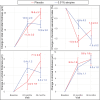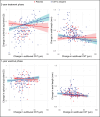Choroidal Changes During and After Discontinuing Long-Term 0.01% Atropine Treatment for Myopia Control
- PMID: 39136629
- PMCID: PMC11323994
- DOI: 10.1167/iovs.65.10.21
Choroidal Changes During and After Discontinuing Long-Term 0.01% Atropine Treatment for Myopia Control
Abstract
Purpose: Few studies have explored choroidal changes after cessation of myopia control. This study evaluated the choroidal thickness (ChT) and choroidal vascularity index (CVI) during and after discontinuing long-term low-concentration atropine eye drops use for myopia control.
Methods: Children with progressive myopia (6-16 years; n = 153) were randomized to receive 0.01% atropine eye drops or a placebo (2:1 ratio) instilled daily over 2 years, followed by a 1-year washout (no eye drop use). Optical coherence tomography imaging of the choroid was conducted at the baseline, 2-year (end of treatment phase), and 3-year (end of washout phase) visits. The main outcome measure was the subfoveal ChT. Secondary measures include the CVI.
Results: During the treatment phase, the subfoveal choroids in both treatment and control groups thickened by 12-14 µm (group difference P = 0.56). During the washout phase, the subfoveal choroids in the placebo group continued to thicken by 6.6 µm (95% confidence interval [CI] = 1.7 to 11.6), but those in the atropine group did not change (estimate = -0.04 µm; 95% CI = -3.2 to 3.1). Participants with good axial eye growth control had greater choroidal thickening than the fast-progressors during the treatment phase regardless of the treatment group (P < 0.001), but choroidal thickening in the atropine group's fast-progressors was not sustained after stopping eye drops. CVI decreased in both groups during the treatment phase, but increased in the placebo group after treatment cessation.
Conclusions: On average, compared to placebo, 0.01% atropine eye drop treatment did not cause a differential rate of change in ChT during treatment, but abrupt cessation of long-term 0.01% atropine eye drops may disrupt normal choroidal thickening in children.
Conflict of interest statement
Disclosure:
Figures







References
-
- Read SA, Alonso-Caneiro D, Vincent SJ, Collins MJ.. Longitudinal changes in choroidal thickness and eye growth in childhood. Invest Ophthalmol Vis Sci . 2015; 56(5): 3103–3112. - PubMed
-
- Prousali E, Dastiridou A, Ziakas N, Androudi S, Mataftsi A.. Choroidal thickness and ocular growth in childhood. Surv Ophthalmol . 2021; 66(2): 261–275. - PubMed
Publication types
MeSH terms
Substances
LinkOut - more resources
Full Text Sources

